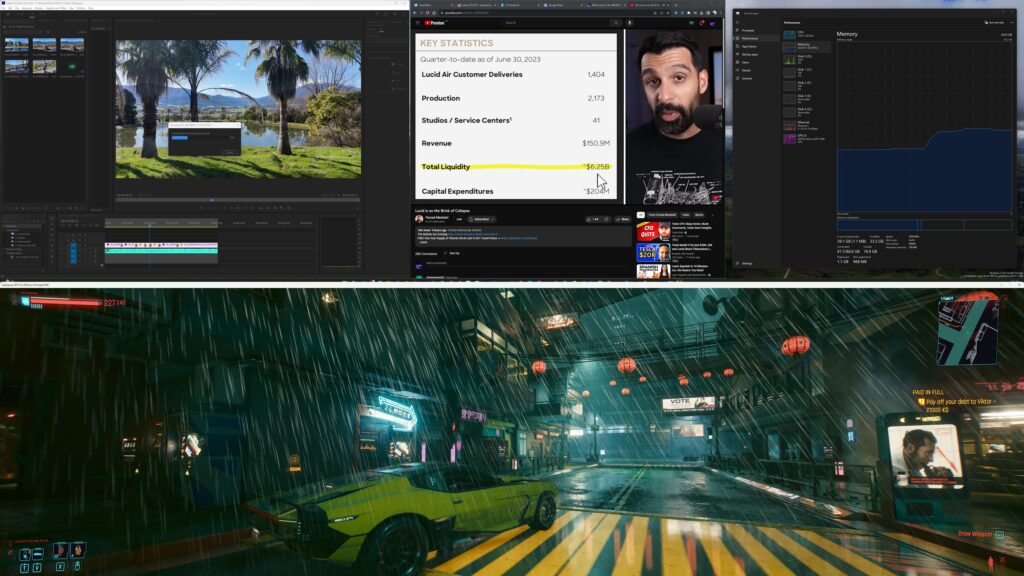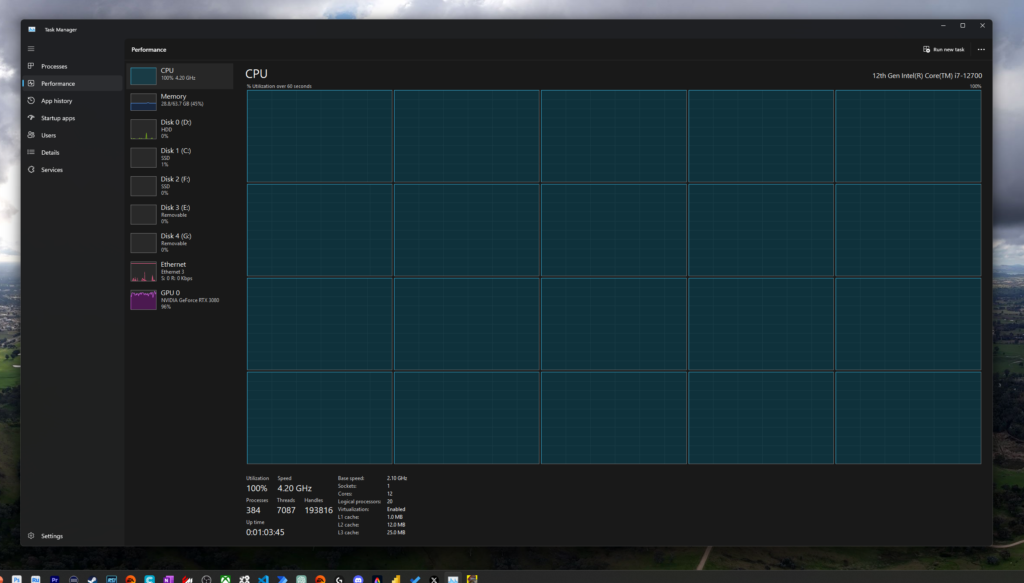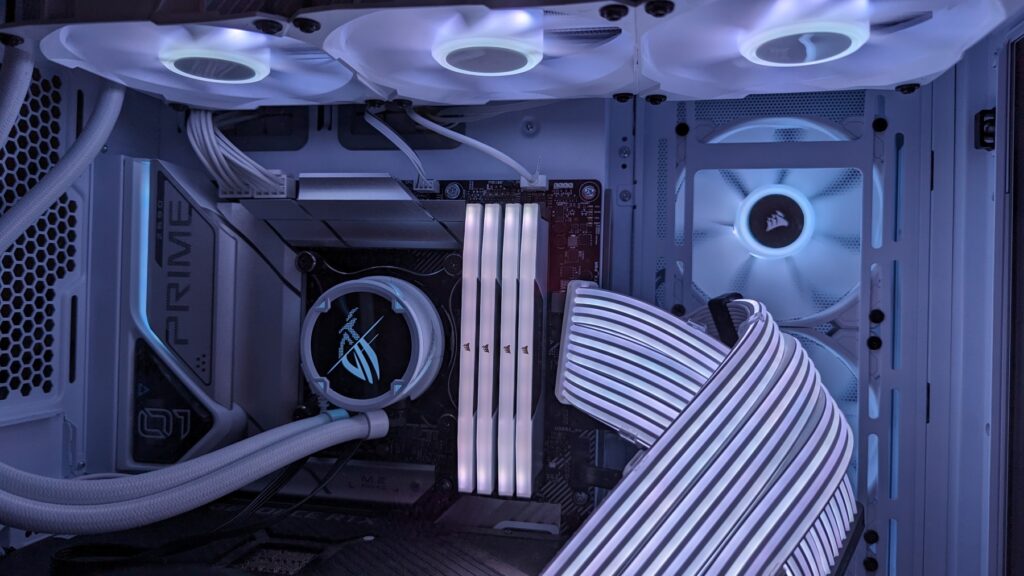Having built a new PC at the end of 2022, I have slowly been tweaking it, adding improvements since the initial build. Upgrading your PC is one of the great opportunities you have over a laptop, allowing the internals to grow as your needs do over time.
To being the post-build mods, I first upgraded the stock Intel 12th-gen CPU fan to the ASUS ROG Strix LC II 360 ARGB (White Edition) which you can read more about here.
From here I keep staring at the two empty RAM slots and thinking, I wonder how different the machine would perform if I filled that with another 2 RAM sticks. Eventually, that got the better of me, so I ordered a second set of the Corsair Vengeance RGB 32GB (2x16GB) 5200MHz CL40 DDR5 in white for a total of 64GB of RAM.
RAM upgrades, even DDR5 ones, are one of the cheapest upgrades you can make to your PC, so it’s a pretty low-cost experiment.
I use my computer for a variety of tasks including the following:
- Gaming (FPS, Racing etc)
- Video editing, rendering
- Photo editing, batch processing
- Blogging
- Posting on Social Media
- Watching YouTube, Netflix, Foxtel etc.
- 3D modelling + slicing for 3D Printing
- Much more
These tasks individually can be taxing on the system, particularly Gaming and Video editing. While I could compare the results of benchmarks in a before and after, the very obvious and more real-world test is simply to run multiple intensive tasks simultaneously and see what happens. In theory, more RAM would make all of this faster, but in reality, was that true? Especially given I had a generous amount (32GB) of pretty fast RAM in the system.

RAM allows the computer to access memory randomly, hence the name, Random Access Memory. This means that any byte of memory can be accessed without having to read through all the preceding bytes, as it would be on say a spinning hard drive, therefore RAM is much faster at a number of common tasks like launching applications, open files, and even booting the operating system.
- Loading programs and files: When you open a program or file, the computer first loads it into RAM. This allows the program or file to be accessed quickly by the CPU.
- Multitasking: RAM allows you to run multiple programs at the same time. This is because the computer can store the data for each program in RAM.
- Graphics: RAM is used to store the data for graphics that are being displayed on the screen. This allows the graphics to be displayed smoothly and without lag.
- Virtual memory: If the computer runs out of RAM, it can use a portion of the hard drive as virtual memory. This allows the computer to continue running programs even if there is not enough physical RAM available.
When it comes to PC performance, there will always be a bottleneck, a component that is the limiting factor.
The test
My test setup contained the following:
- Run 2x 5120×1440 Samsung Ultrawide Monitors (14.7 Million pixels).
- Run Chrome with tabs for TweetDeck, Facebook, Gmail, techAU, Google News, YouTube)
- Steam
- Cyberpunk 2077
- Adobe Premiere exporting a 4K video


The Result
I’ll start by saying that I continue to be impressed by what my machine can do regarding performance, it’s a huge leap forward from what I had before and it certainly wasn’t a case of an unlimited budget.
What I found was that regardless of all the things I threw at it (simultaneously), it consumed a maximum of just 30.6GB of RAM. This means in theory, this workload would have fit inside the previous 32GB envelope. In reality, it is always nice to have some additional capacity up your sleeve.


What I actually observed was the Nvidia GeForce RTX 3080 being taxed to 83%, which means while it was heavily used for rendering the insane visuals of Cyberpunk 2077, it was not the limiting factor, the CPU was.
My CPU is the Intel Core i7 12700 3.6GHz (4.9GHz max clock speed) running 20 Threads across 12 cores. At one stage during the test, we see a complete 100% utilisation, this is the limiting factor.
So from this experiment, you can see that running 64GB does not necessarily deliver extra performance, and in most instances, you don’t need more than 32GB of RAM, outside someone who’s running a bunch of hungry Virtual Machines.


For me, there is an upgrade path for the CPU, the ASUS motherboard I selected actually supports 12th and 13th-generation Intel chips with the LGA1700 socket. While the RAM cost was a fairly inexpensive upgrade at A$169, upgrading the processor is a A$600-700 proposition and something that can be done in the future should my needs require it.
After a CPU upgrade cures that bottleneck, we’d then circle back to the GPU and that’d probably mean an RTX 4080 in white, which is currently north of A$2k and the cycle starts over again.



I got 64gb (2×32) 6400mhz ddr5 for my 12700k. My b760 supports 14thgen, also pcie5.0 so figured 64gb is future proof.
I also didn’t have many options for qvl ram, wanted fasted possible speed. My 32gb (2×16) sticks wouldn’t boot xmp but luckily the 64gb dual rank does.
Hi Jason. Thanks for the 64GB Ram article. I belong to the Cairns Mens Shed and we are upgrading our 3 PC’s which will be sent out to pasture in Jurassic Park.
Kind Regards,
John Campbell